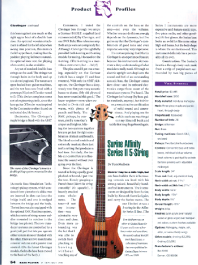Product Profile: Surine Affinity Series II 5-String
By Tom Mulhern
Bass Player Magazine
September/October 1993

Displayed with Permission of MusicPlayer, Inc.
Denver may be a mile high, but one bass builder there is burrowing towards sea level with his strong-voiced, beautifully handcrafted instruments. The instruments are designed by Scott Surine, built by Kenneth Scott Lofquist, and carry the Surine name. The one I looked at was a 5-string in the Affinity Series II line. (The Series I instruments are more expensive and feature exotic tops, five-piece necks, and other goodies.) At first glance, the Surine bass looks an awful lot like some other high-end basses, but the body shape is where the similarities end. This instrument definitely has a personality all its own.
Construction. The Surine’s heart is a through-body neck made from a strip of purpleheart surrounded by two big pieces of maple. Honduras- mahogany body wings, set off by two thin strips of purpleheart, ank the neck; the headstock overlay matches the wings, unifying the instrument’s look. The combination of the maple neck and rosewood fingerboard makes for a strong, woody tone.
Many 5- and 6-string basses are neck-heavy; Surine alleviates this problem with a small peghead. When you play the bass on your lap, the neck still searches for the floor, but on a strap the balance is pretty good. (I’m not sure a 5-string can be much less neck-heavy than this, short of using a headless design.)
The Affinity II has dual truss rods-a good idea for just about any extended-range bass, since they offer a lot more adjustment flexibility than a single truss rod. I didn’t have to adjust the test instrument’s neck or bridge; intonation was excellent, as was the neck relief, and there were no buzzes or rattles. The truss-rod adjusters are camouflaged under two recessed cover blocks that t into cavities in the body; a tiny phillips-head screw holds each in place.Electronics. I was initially unconvinced that a volume control for each pickup is a good approach (as opposed to master-volume and blend knobs); however, the more I played the Surine, the more I embraced this concept. By setting the bridge pickup wide open and backing o on the neck pickup’s volume by about a quarter, I got a good biting sound. Then, when I wanted to drop to the basement, I just rolled the neck volume up. Bottom floor-everybody out!
